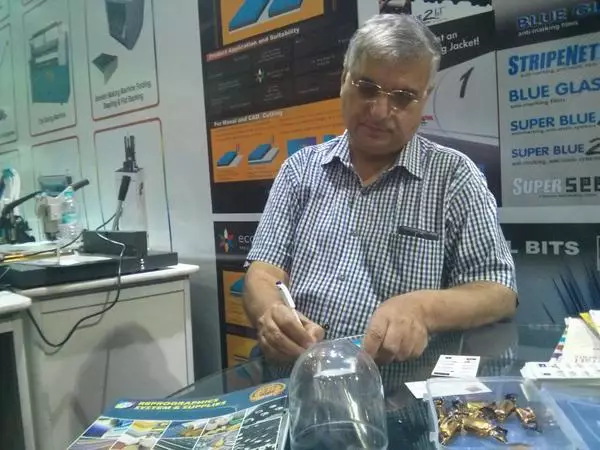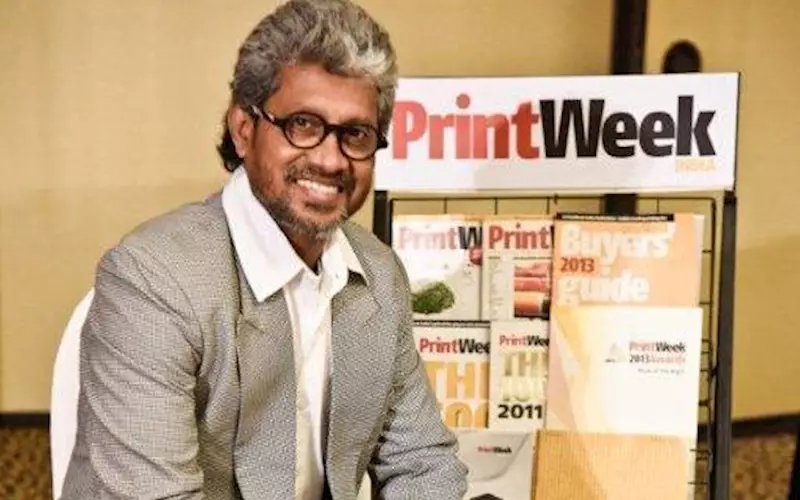While expenses on consumables are unavoidable, keeping the cost down by way of buying cheaper products is an option that is very tempting. However, blankets is the soul of printing. At the end of the day, blankets transfer the printing dot on the paper and the quality of printing blanket you use determines the quality of your print.

“If you are conscious of quality of ink, paper, then why ignore blanket,” asks KJ Paul, director at Reprographic System & Supplies, the Indian representative for Conti blankets. “Ordinary quality blankets sinks quickly in comparison to the quality blankets. In such case, you are not printing on paper but painting on paper. During various trade shows, we are at pain to get buyers to understand this concept, and it can be quite difficult," he says.
The USP and type blankets
A lot of business does depend on the price factor which comes in is finding the right product. Vishal Group’s director Vishal Laddha says, it would be wrong to call it as the USP of our blankets. The company distributes Cow blankets. “This product needs no introduction or marketing. We at Vishal call it UBP, our unique buying proposition.
There are various types of blankets available, for different applications. For example, Laddha says, “We have the Duco range, a versatile product for sheetfed and web offset for high speed as well as dedicated UV printing.”
Blanket consumption in India

Rohit Madan, managing director of RM Associates, says, it is difficult to estimate the consumption of blankets since it depends on the size of the printing machine, type of jobs and printing substrates being used. “Besides, there are no actual import figures available. However an indicative figure, that a Heidelberg CD-102/4C will consume minimum of 50 sq/mtrs and similarly a CD-74/4C would consume a minimum of 25 sq/mtrs in a year.” Madan’s RM Associates sells approximately 1,200 sq/mtrs a year.
Laddha, however, puts a number to the total consumption of blankets in India. “It’s around 1.50-lakh sq/mtr of blankets are sold every year,” he says. “Last year we sold 45,000 sq/mtrs and this year we are aiming at 50,000 sq/mtrs.”
Popular blankets
Among blankets, the popular ones are Day (Cow), Meiji, Kinyo, Rollin, Vulcan and Phoenix.
About three decades ago, there used to be Cow blankets which was considered the most popular blanket. “With no established players in India, there was no competition to Cow. Plus there was no competition in prices. Every blanket has its niche market depending on service, quality and availability.”
Blankets from China are also penetrating the Indian market, plus European and Japanese blanket makers are setting up blanket plants in India. “This is mainly for cost reduction purposes,” says Madan. “The Chinese companies mainly cater to the large Asian market, however, one needs to check the genuineness of the brand produced before buying the blankets.”
 Selection and maintenance
Selection and maintenance
Each printing press has a different specification like size, thickness, aluminium bars (clamps) etc. And each blanket has its own unique features and printers use it as per their job requirements. “Blankets usually come in two thickness – three ply/1.70mm and four ply/1.95mm. This thickness is undermined by the undercut on blanket cylinder,” says Laddha.
PrintWeek India spoke to two printers, and this is what they had to say. Faheem Agboatwala of Hitech Printing Services, says, “Consistency is a key when choosing blankets and therefore we tend to import directly from the manufacturer. The cons is that we have to invest in a six-month stock and plan well in advance, the pros are you don’t get any stock lots and reduce the variance factor.”
Anil Daniel of Anitha Art Printers, says, “I’ve been using Cow compressible blankets. I tried using other blankets but was not happy with the life of the blanket. Usually a blanket lasts for three months, but if there is negligence on the printers side like double paper or a particle in the paper, the blanket can get damaged.”
Maintenance really depends on the press condition, press room chemicals, inks, quality of paper and handling. “We highly recommend weekly maintenance with Varn Take-it-off jelly deglazer and Varn fount clean, so as to increase the life of a blanket, printing machine and thus improve in print quality,” says Laddha.
 Demand and availability
Demand and availability
“The Indian market is no different than most markets in a upcoming country – everyone wants the best at the lowest price,” says Nitin Ahuja, managing director of And Systems, representative for Kinyo and Tru Air blankets in India.
India by far is the largest market for printing consumables, says Laddha. “Large market means large number of buyers having different needs. To cater to this huge requirement many competing blankets have come into play.”
Ahuja adds, “The only worry is that the Indian market starts believing that they are being offered the best option in the price range they are looking for.”
The biggest threat therefore, comes in the form of counterfeit, seconds and stock lots blanket. Madan of RM Associates, the dealer for Meiji blankets, says, “There are certain importing dealers who only import such blankets and sell at 50% of the cost of prime blankets to the sub-dealers. This confuses the customer tremendously due to the price difference until he faces a quality issue.”
 “If you are conscious of quality of ink, paper, then why ignore blanket,” asks KJ Paul, director at Reprographic System & Supplies, the Indian representative for Conti blankets. “Ordinary quality blankets sinks quickly in comparison to the quality blankets. In such case, you are not printing on paper but painting on paper. During various trade shows, we are at pain to get buyers to understand this concept, and it can be quite difficult," he says.
“If you are conscious of quality of ink, paper, then why ignore blanket,” asks KJ Paul, director at Reprographic System & Supplies, the Indian representative for Conti blankets. “Ordinary quality blankets sinks quickly in comparison to the quality blankets. In such case, you are not printing on paper but painting on paper. During various trade shows, we are at pain to get buyers to understand this concept, and it can be quite difficult," he says. Rohit Madan, managing director of RM Associates, says, it is difficult to estimate the consumption of blankets since it depends on the size of the printing machine, type of jobs and printing substrates being used. “Besides, there are no actual import figures available. However an indicative figure, that a Heidelberg CD-102/4C will consume minimum of 50 sq/mtrs and similarly a CD-74/4C would consume a minimum of 25 sq/mtrs in a year.” Madan’s RM Associates sells approximately 1,200 sq/mtrs a year.
Rohit Madan, managing director of RM Associates, says, it is difficult to estimate the consumption of blankets since it depends on the size of the printing machine, type of jobs and printing substrates being used. “Besides, there are no actual import figures available. However an indicative figure, that a Heidelberg CD-102/4C will consume minimum of 50 sq/mtrs and similarly a CD-74/4C would consume a minimum of 25 sq/mtrs in a year.” Madan’s RM Associates sells approximately 1,200 sq/mtrs a year. Selection and maintenance
Selection and maintenance Demand and availability
Demand and availability











 See All
See All